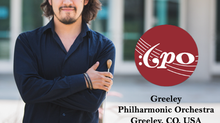How to get 147000 diversified audience for a single show? Learnings from the For-Profit Sector
- Diego Barbosa-Vásquez
- Feb 10, 2023
- 10 min read
Updated: Dec 7, 2024
Building bridges between communities and art practices has been in the center of my job and life since I accepted my first Music Directorship back in 2008. Since then I understood that allowing and helping the “general population”(1) to see and experience different artistic forms will become a fundamental element of my artistry. My two decades of international personal experiences and my Post-Doctoral research have convinced me that the Artistic experience is complete ONLY when it creates a communication between the artists and the communities they serve. There are multiple ways in which we, as arts leaders, could develop this communication (as you can see more in depth Barbosa-Vasquez/Academic). And one of it is of course how our programming, its outreach, and all the marketing efforts around it could create the bridges for communities. There are multiple ways in which artistic organizations have been developing this building bridges efforts. However, in a general view of the Performing Arts non-profit sector, there is a lack of review of which elements from the For-Profit sector could be learned and probably implemented in our community development efforts.

That is why I want to share a reflection about Invitation to the Party(2) a book by Walker-Kuhne that shares, from the for-profit performing sector, wonderful resources that could give us other perspectives about how this building bridges process could be done. In addition to some preliminary clarifications of the Audience Development history and strategies “10 Tools for Building Audiences”, the book has short descriptions about successful Community Development efforts lead by the author. One of them is the Harlem Song, a musical written by Wolfe that was premiered in the emblematic Apollo Theater. A history that described the African American and Latin American history of Harlem (though the clarification of Latin America part is not very clear). According to Walker-Kuhne, the full Audience Development strategy (or community development as we called in the non-profit sector) was based on getting the African American communities into the 170 shows (YES 170) that this musical did during 4 months(3). I consider that the full description of how they were able to achieve that goal is fascinating and worthy to analyze and could give us very interesting ideas that can be applied to our orchestra, opera and ballet companies seasons and long term development.
Of course the first component to analyze is why this matters to me and why I am writing about it. In addition to the reasons described before, as a Conductor and Scholar with strong Opera background, musicals are for me one of the areas of constant artistic and administrative research and reflections. As argued on another paper, Musicals are one of the for-profit development of the Opera(4). Both share the “Music, Sung Drama, and Spectacle unified art form” definition, and both art forms are performance based. There are even multiple actors that usually work on both fields in a professional way. From musicians, conductors, singers, directors, or arts administrators, and stage managers. At the end, the crucial difference is only find in the way the non-profit or for-profit business model influences the full governing models of each art(5). And this is why the study of the Harlem Song becomes very interesting for me and worthy to analyze in its components to see which parts could be applied to the Non-Profit Performing Arts sector.
Because of the For-Profit business model that makes possible the full enterprise, the Harlem Song Musical full Audience Development was not seen as a secondary element and instead is a fundamental element of the project. That is different of how non-profits performance organizations work by expending most of its resources on the artistic and organization development because at the end, no matter how many people attend, the budget will be subsidized. Let's remember that in general performance organizations has a business model of at least 50% to 60% of their full income coming from contributed sources.

On the other hand, in for-profit models, Audience is a fundamental element of the full project. Tons of people MUST to see the show and the show must produce income. If the production is not sufficiently attractive for wide audiences, it is not done, simple. I guess that this is something that is very important to apply to our orchestras, and ballet and opera companies. Not because we wanted to generate profit (or yes? why not?)(6). And also NOT to say that some shows should not be produced, no that is precisely where the Non-Profit sector exist, to be sure money logics are not the real curators of the artistic experiences. The application of this "Audience as a MUST" logic is important because putting the audience as the fundamental center of the enterprise is the most important element of doing art. We as artist must to take care of doing the best possible art, that’s mandatory, and as as conductor/music director this is in fact my principal role being sure we get our best possible performance every single time. But we also need to be sure this experience is shared properly with the audience with our communities. If they are not there, we are not doing art, we are not creating communications, and we are just doing expensive rehearsals to very few people.
With that in mind, I want to point out some Audience Development elements described by Walker-Kuhne that I consider worthy to be though and probably applied to our Orchestras, and Ballet and Opera companies based on their own uniqueness and the projects and seasons they are developing.
The first element that immediately took my attention was the multilevel collaboration between multiple actors or stakeholders around the Audience Development. Once again, because the business model here requires tons of people to actually be able to do the show (147000 people for all performances), producers, staff, composer, singers/actors, musicians, community members, group tickets sellers, etc; were required to participate into a very complex matrix of collaboration(7). At the end, only if each person was putting their best effort into “creating audience” the project could become successful. The way they generated that collaborationcould give some important clues for audience development for our non-profit organizations.

The author describes that this multilevel collaboration started with the producers, the marketing consultors and the audience development committee (comprised by 3 experts on the field and with strong contacts on the communities, in this case African American (non LatinAmericans probably that explains the lack of clarification in that part). All of them had clear that only by getting into the 221k audience target the project was possible(8). It implied that, because the show was actually not fully written in these preliminary collaborative sessions, all actors at this level were required to make adjustments to their thoughts and goals in order to create a feasible project. It included recommendations (from the producers) to creators of the show. By the way, a similar procedure that was done with famous and very successful operas and symphonies where after pre-official or even official premieres some changes were made by creators. Something that we usually tend to forget in the performance field, but those changes were made primarily because of full scope artistic coherence, audiences responses and practical issues with the performers.
After this high-level collaboration was stablished in the Harlmen Song, the community development committee was in charge of expand their efforts and attract more people into their circle. This strategy is fascinating for me as follows basic patterns of social and community participation, and is something we can do perfectly with our orchestras and opera and ballet companies. While multiple brainstorming sessions of possible vehicles of Audience Development activities were developed, the committee was also developing a strong list of more than 1000 community leaders that could relate strongly with this activities and themes. Both elements arrived to the creation of 7 sub-committees (see quote), that then will be filled by more than 250 volunteers(9)
“Public Relations, faith based, special events, education, online promotions,
lesbian and gay, and urban professionals - committees”(10)

The Second Elements is of course, the question of how they went from a 3-person committee to a full committee of more than 250 people? Well they did a pre-premiere special activity where this selected list of possible leaders were able to listen some parts of the Musical, know in advance the full story, and become part of its development. The full concepts behind the story were explained in depth to the 400 people that attended(11). This is very powerful, because with this the audience development committee was able to create a very strong pool of people that not only now became the ambassadors of the project, but also the ears and ideas generators of how to connect better with the audiences. That is very similar of what we did with the Collaborative Arts Summer Camp 2022 in a smaller scale in Los Angeles, and we know is very powerful. We started with community leaders helping them to know very in depth the program and selected story. And level-by-level of community relations encourage more and more people to join us until an amazing art experience was produced(12).
The Third Element: Exponential escalation: From there, the next steps described by Walker-Kuhne can be summarized in collaborate wisely and respectfully with this amazing pool of community allies. Not only to broadcast the full events, activities, website resources, but also receiving from them valuable input about how effective these actives were performing, and how to adjust them better for their expected results. It allowed the creation of activities in churches, education activities on schools (with their respective grants support that is great), and lectures around the topic of the musical that is crucial for the community.
Extra Elements: There are three more elements about Audience development strategies I want to highly here that I consider very valuable for the Orchestra and Opera and Ballet companies. In fact we are researching in a much more deep sense with the Performing Arts Laboratory, therefore keep in touch because soon we will be sharing some advances in that front too. Those are the collaborations with Group Sales agencies, and the partnership with other entities as restaurants, transit providers, hotels, etc.
Both are crucial in the full Audience Development and Economic influence of the arts in society for two main aspects. First, because the relation with sales agencies, that implies sharing around 15 – 20% of sales with them, create a new set of possible audiences that could not be possible without them. It also creates a full set of economic activities that benefit not only the audiences but also the organizations and the artistis involved. Second, because according to the data provided by the author, the collaborations with other entertainment/experience services providers (as restaurants, transit providers, hotels, etc.) created for them an increase of 400% of revenue for the partners(13). A fact that proves the strong value of the artistic practice not only from the humanistic, social and soul health element for the city, but also from an economic and financial perspective. An element that also open the doors for other kinds of revenue and business models with sponsorships and shared costs between producer entities and allies.
Finally, there is a very important question that arrived for me by a fact briefly expressed by Walker-Kuhne that consider that is a fundamental element to consider in community development. The full Audience development activities and strategies for this project were crafted to highlighting the “African American Experience”(14) as the author describes it. In adddition, from the 221k target audiences, they only got 147k in 2 different waves(15). First from Harlem -people that usually returned-, and second from Brooklyn that is heavily African American population too(16). Both elements create a very important question, could a broader target audience and therefore marketing and audience development strategies that included the broad United States experience be more successful? It for sure will allowed more people to feel connected to the topic. However, at the same time, it could change this strong commitment of people that seen in this show their voice and experience being broadcasted and crafted specially from them.
This dichotomy is for sure a very interesting topic to consider in our arts institutions and the way we develop our community development models. On the non-profit sector we usually develop our projects opening the doors to all (or at least in paper becase the reality is totally different I must clarify). In many ways, as a general view (with some exceptions of course) we target the full audiences as equals. In addition, the traditional Operatic and Symphonic repertoire is considered “Universal” or able to reach all people(17). But for a marketing strategy and community development models is that best way to go? Could be allowing other voices to be listen in their own circles the response? Or is a cleverly and well planned mixture of both the best way to accomplish that?
I am personally more inclined for the last one as you can see on my Music Directorships programming. But this is of course based on three elements. First, my very diverse repertoire, worldwide triaining, and very diverse background where I feel equality in home conducting Mahler, Beethoven, Piazzola, Marquez, Tchaikovsky, el Joe, etc. The fact that audiences see me as an part of both worlds allowing me to have the "authority" to guide them through these very diverse repertoires, cultures, and values behind the music. And of course the flexibility that a full season proposal gives and the strong support of the boards and administrative executives I have collaborated with. However, this is a topic that for sure requires more in depth analysis. Some of them are part at my Doctoral Dissertation Chapter 2, and others are being analyzed by at the Performing Arts Laboratory at International and multi-local levels. But what do you think about it? I'd love to know your opinion about that topic.
In conclusion, despite the fact that Musicals are in a For-profit model, the value they put into audience development is something we should replicate in our orchestras and opera and ballet companies. Our community focus could and MUST compensate our lack for profit goal. At the end, for both of us the more people enjoying and experience art the better for us. In fact, that is what our Missions and Visions say in the Non-profit sector. We both are looking for the same, multiple people having art as part of their lives. That is why this book was very interesting to me sharing multiple elements and questions we are working on in the Performing Arts Laboratory. It shows me that we are in the correct path and that Performing Arts sustainability is possible if we continue learning from other models and collaborating between multiple actors, sectors, and fields.
Footnotes:
1. For a lack of a better term that embraces the people that is usually connected or participant of artistic
experience.
2. Walker-Kuhne, Donna. Invitation to the Party: Building Bridges to the Arts, Culture and Community. New
York: Theatre Communications Group, 2005.
3. Walker-Kuhne, Donna. Invitation to the Party: Building Bridges to the Arts, Culture and Community. New York: Theatre Communications Group, 2005. Page 127
4. Barbosa-Vasquez, Diego. “Ostrom Workshop Research Series: Opera Sustainability: Through Multilevel-Apprenticeship Programs at Opera Companies.” Video. Ostrom Workshop. Mar, 2021. https://www.youtube.com/watch?v=PfdemPODRlM.
5. Ibid.
6. That is an important question we need to do. We are developing researches more in depth about possible B-Corporation models as possible solutions for Arts Sustainability under today’s challenges.
7. Walker-Kuhne, Donna. Invitation to the Party: Building Bridges to the Arts, Culture and Community. New York: Theatre Communications Group, 2005. Page 128
8. Ibid.
9. Ibid. Page 120
10. Ibid.
11. Ibid.
12. Barbosa-Vasquez, Diego. “Opera by and for the Community: Collaborative Arts Summer Camp 2022. Barbosa-Vasquez, 15 July 2022, https://www.barbosavasquez.com/single-post/opera-by-and-for-the-community-collaborative-arts-summer-camp-2022
13. Walker-Kuhne, Donna. Invitation to the Party: Building Bridges to the Arts, Culture and Community. New
York: Theatre Communications Group, 2005. Page 128
14. Ibid. Page 127
15. Ibid. Page 127
16. Ibid. Page 127
17. However, we all know that statistically is mainly Eurocentric focused.































Comments